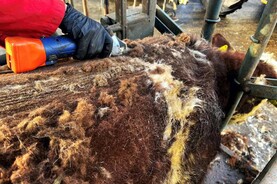Cattle housing has commenced on Tullamore Farm, with bull weanlings housed and weaned off cows last week.
The plan was to return some cows to grass, but as grass supplies have started to diminish and with an increasing demand from the sheep flock over the mating season, the decision was made to hold these cows indoors.
Bull weanlings are currently being offered ad-lib good-quality 73% DMD baled silage and 3kg of a 16% protein weanling ration.
Bulls were dosed for lungworm and received a third booster shot against pneumonia after receiving two shots as calves in spring.
This has proved effective in years gone by, with the farm having little to no issues with post-housing pneumonia. They also received a booster shot for IBR pre-weaning.
Gradual process
These cattle were weaned in a gradual process, having been housed on straw lieback with access to their mothers morning and evening for the first three days.
The time spent locked away from their mothers gradually increased before being restricted completely from cows.
On-off grazing was practiced during the weaning process, where weanlings had access to grass during the day before returning to the shed for silage and meal at night.
This was done in a bid to reduce dietary upsets on the changeover from grass to silage.
Heifer weanlings belonging to cull cows have been weaned and returned to grass, with the remainder of heifer calves still grazing with their mothers.
These calves are being encouraged to forward graze, with the wire lifted and a trough outside with 2kg/head of ration offered daily - this is working well, with most of the calves now travelling under the wire ahead of the cows and helping to break the bond with their mothers.
Cull cows
Seventeen cull cows are housed on slats and are being built up on a high-maize ration, with 6kg/head being offered daily, along with 73% DMD silage at present.
Ten poorer-conditioned and older cull cows returned to grass and are being offered 3kg at grass to try to build condition as cheaply as possible before being housed for finishing in the coming weeks.
The farm is carrying a higher number of culls this year due to a combination of decisions made, including a stricter culling policy being applied for age and quality.
April calvers were also removed from the system and breeding finished three weeks earlier than usual in an effort to tighten calving spread, which also contributed to the higher empty rate.
The farm will be able to directly replace these cows with in-calf heifers, with the farm deciding not to hold its annual sale of heifers this October in a bid to increase numbers and pull back to an earlier calving date.
Sheep flock
Mating has begun in the sheep flock, with 190 mature ewes joining with rams this week, with a targeted lambing start date of 10 March 2025.
Ewes are in good condition, with flushing commencing three weeks pre-mating. Single-sire mating is being practiced once again this year.
Seventy ewe lambs will be joined with rams in two weeks’ time and rams will be swapped between groups.
A more detailed report will be available on this year's breeding strategy and performance as breeding progresses in the next few weeks. Fifteen 2024-born ewe lambs remain on farm, with 200g/head/day of concentrate being introduced this week to put adequate flesh on these lambs pre-slaughter.







 This is a subscriber-only article
This is a subscriber-only article










SHARING OPTIONS: